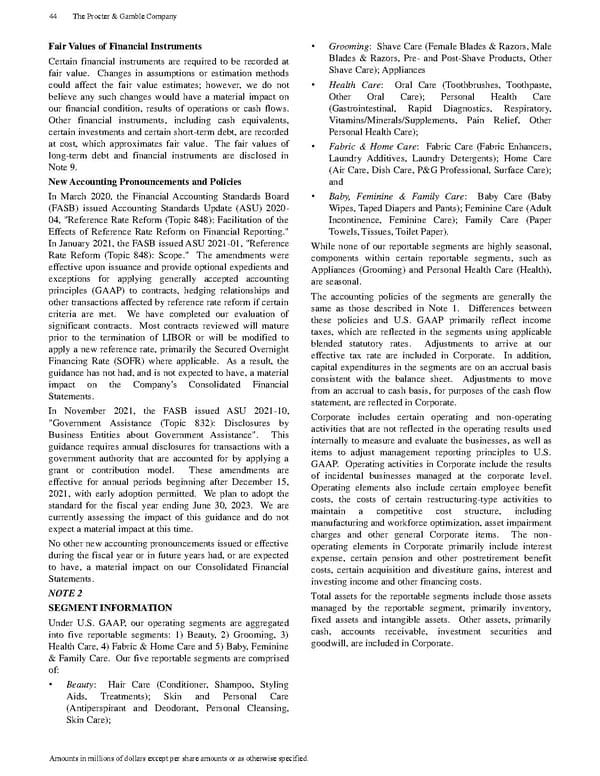Fair Values of Financial Instruments Certain financial instruments are required to be recorded at fair value. Changes in assumptions or estimation methods could affect the f air value estimates; however, we do not believe any such changes would have a material impact on our financial condition, results of operations or cash flows. Other financial instruments, including cash equivalents, certain investments and certain short - t erm debt, are recorded at cost, which approximates fair value. The fair values of long - term debt and financial instruments are disclosed in Note 9. New Accounting Pronouncements and Policies In March 2020, the Financial Accounting Standards Board (FASB) i ssued Accounting Standards Update (ASU) 2020 - 04, "Reference Rate Reform (Topic 848): Facilitation of the Effects of Reference Rate Reform on Financial Reporting." In January 2021, the FASB issued ASU 2021 - 01, "Reference Rate Reform (Topic 848): Scope." T he amendments were effective upon issuance and provide optional expedients and exceptions for applying generally accepted accounting principles (GAAP) to contracts, hedging relationships and other transactions affected by reference rate reform if certain c riteria are met. We have completed our evaluation of significant contracts. Most contracts reviewed will mature prior to the termination of LIBOR or will be modified to apply a new reference rate, primarily the Secured Overnight Financing Rate (SOFR) whe re applicable. As a result, the guidance has not had, and is not expected to have, a material impact on the Company's Consolidated Financial Statements. In November 2021, the FASB issued ASU 2021 - 10, "Government Assistance (Topic 832): Disclosures by Business Entities about Government Assistance". This guidance requires annual disclosures for transactions with a government authority that are accounted for by applying a grant or contribution model. These amendments are effective for annual periods beginning after December 15, 2021, with early adoption permitted. We plan to adopt the standard for the fiscal year ending June 30, 2023. We are currently asse ssing the impact of this guidance and do not expect a material impact at this time. No other new accounting pronouncements issued or effective during the fiscal year or in future years had, or are expected to have, a material impact on our Consolidated Fi nancial Statements. NOTE 2 SEGMENT INFORMATION Under U.S. GAAP, our operating segments are aggregated into five reportable segments: 1) Beauty, 2) Grooming, 3) Health Care, 4) Fabric & Home Care and 5) Baby, Feminine & Family Care. Our five reportable seg ments are comprised of: • Beauty : Hair Care (Conditioner, Shampoo, Styling Aids, Treatments); Skin and Personal Care (Antiperspirant and Deodorant, Personal Cleansing, Skin Care); • Grooming : Shave Care (Female Blades & Razors, Male Blades & Razors, Pre - and Post - Shave Products, Other Shave Care); Appliances • Health Care : Oral Care (Toothbrushes, Toothpaste, Other Oral Care); Personal Health Care (Gastrointestinal, Rapid Diagnostics, Respiratory, Vitamins/Minerals/Supplements, Pain Relief, Other Personal Hea lth Care); • Fabric & Home Care : Fabric Care (Fabric Enhancers, Laundry Additives, Laundry Detergents); Home Care (Air Care, Dish Care, P&G Professional, Surface Care); and • Baby, Feminine & Family Care : Baby Care (Baby Wipes, Taped Diapers and Pants); Feminine Care (Adult Incontinence, Feminine Care); Family Care (Paper Towels, Tissues, Toilet Paper). While none of our reportable segments are highly seasonal, components within certain reportable segments, such as Appliances (Grooming) and Person al Health Care (Health), are seasonal. The accounting policies of the segments are generally the same as those described in Note 1. Differences between these policies and U.S. GAAP primarily reflect income taxes, which are reflected in the segments using applicable blended statutory rates. Adjustments to arrive at our effective tax rate are included in Corporate. In addition, capital expenditures in the segments are on an accrual basis consistent with the balance sheet. Adjustments to move from an accr ual to cash basis, for purposes of the cash flow statement, are reflected in Corporate. Corporate includes certain operating and non - operating activities that are not reflected in the operating results used internally to measure and evaluate the businesses , as well as items to adjust management reporting principles to U.S. GAAP. Operating activities in Corporate include the results of incidental businesses managed at the corporate level. Operating elements also include certain employee benefit costs, the costs of certain restructuring - type activities to maintain a competitive cost structure, including manufacturing and workforce optimization, asset impairment charges and other general Corporate items. The non - operating elements in Corporate primarily incl ude interest expense, certain pension and other postretirement benefit costs, certain acquisition and divestiture gains, interest and investing income and other financing costs. Total assets for the reportable segments include those assets managed by the reportable segment, primarily inventory, fixed assets and intangible assets. Other assets, primarily cash, accounts receivable, investment securities and goodwill, are included in Corporate. 44 The Procter & Gamble Company Amounts in millions of dollars except per share amounts or as otherwise specified.
 The Procter & Gamble Annual Report Page 55 Page 57
The Procter & Gamble Annual Report Page 55 Page 57